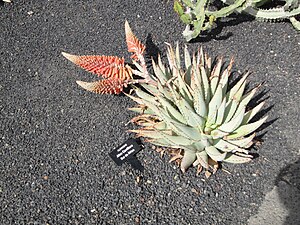Aloe claviflora
| Aloe claviflora | ||||||||||||
|---|---|---|---|---|---|---|---|---|---|---|---|---|

Aloe claviflora |
||||||||||||
| Systematics | ||||||||||||
|
||||||||||||
| Scientific name | ||||||||||||
| Aloe claviflora | ||||||||||||
| Burch. |
Aloe claviflora is a species of the genus Aloes in the subfamily of the Affodilla plants (Asphodeloideae). The specific epithet claviflora is derived from the Latin words clava for 'cone' and -florus for 'bloomy' and refers to the cone-shaped flowers of the species.
description
Vegetative characteristics
Aloe claviflora grows without a trunk or with prostrate shoots and usually forms circular, empty groups with a diameter of 1 to 2 meters inside. The shoots are 10 to 20 centimeters long, the rosettes prostrate. The 30 to 40 ovate-lanceolate leaves form dense rosettes. The glauke leaf blade is about 20 inches long and 6 to 8 inches wide. On the underside of the leaf there are one to two keels in the upper third, which are covered with four to six brownish spines 2 to 4 millimeters in length. The stinging, brownish teeth on the leaf margin are 2 to 4 millimeters long and about 10 millimeters apart.
Inflorescences and flowers
The crooked, almost horizontal inflorescence is simple or consists of one to four branches and reaches a length of up to 50 centimeters. The dense, cylindrical, pointed grapes are 20 to 30 centimeters long. The ovoid-pointed, knocked back bracts have a length of about 15 millimeters and are 6 to 8 millimeters wide. The red, frosted, green-tipped flowers are on 7 to 10 millimeter long peduncles . After pollination, they become lighter and change color to lemon-yellow to ivory-colored. The flowers are 30 to 40 millimeters long and narrowed at their base. Above the ovary , they are expanded to 10 millimeters. Your outer tepals are not fused together over a length of 15 to 20 millimeters. The stamens and the style stick out 15 millimeters from the flower.
genetics
The number of chromosomes is .
Systematics and distribution
Aloe claviflora is common in the South African provinces of the North Cape , Western Cape , Eastern Cape and Free State on well-drained, flat, stony soils or rocky slopes.
The first description by William John Burchell was published in 1822.
Synonyms are Aloe Bad Schönland (1903) and Aloe decora Schönland (1905).
proof
literature
- Susan Carter , John J. Lavranos , Leonard E. Newton , Colin C. Walker : Aloes. The definitive guide . Kew Publishing, Royal Botanic Gardens, Kew 2011, ISBN 978-1-84246-439-7 , pp. 408 .
- Leonard Eric Newton: Aloe claviflora . In: Urs Eggli (Hrsg.): Succulent lexicon. Monocotyledons . Eugen Ulmer, Stuttgart 2001, ISBN 3-8001-3662-7 , pp. 126 .
Individual evidence
- ↑ Urs Eggli, Leonard E. Newton: Etymological Dictionary of Succulent Plant Names . Springer, Berlin / Heidelberg 2010, ISBN 978-3-642-05597-3 , p. 49.
- ^ William John Burchell: Travels in the interior of southern Africa . Volume 1, Longman, Hurst, Rees, Orme & Brown, London 1822, p. 272 ( online )
Web links
- Aloe claviflora in the Red List of South African Plants
